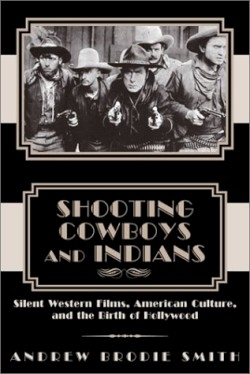Shooting Cowboys and Indians
Silent Western Films, American Culture, and the Birth of Hollywood
The movie Western was more than a quarter of a century old by the time Gene Autry galloped onto the screen in the mid-1930s. It had evolved during the silent-film era from a thinly disguised artifact of civic boosterism into a formulaic narrative with plenty of action and a strong-jawed hero. The author’s research is deep and wide, and the photos he supplies impart a vivid feel for the period.
The most surprising element of this study is how many “modern” issues already existed at the birth of the Western—the coarsening of popular taste, outcries for censorship, complaints of racism, the impact of “star” personalities in selling films, and the proper role of women. Smith (who holds a Ph.D. in history from the University of California and now works as a writer, book dealer, and consultant for nonprofit organizations) explains the business factors that led the nascent American movie industry—initially centered in Chicago and New York—to find a more congenial home in and around Los Angeles.
The first Westerns were shot in Colorado in 1906, but were not recognized as a distinct film genre until the following year. At this point, the films were quite short—“one-reelers”—and were as much about the gorgeous natural locales as about story and action. Other forces shaping the Western were British crime films, wild-west shows, and stage melodramas.
So great was the early Western’s appeal, Smith reports, that film crews wandered America seeking out locations-a job made easier by the fact that railroads sometimes provided free transportation in exchange for promotional footage. These wanderings led the industry to Los Angeles, where, in 1909, the first film factory was established.
All this attention, of course, spawned controversy—about the impact on youth of the violence depicted, about the representation of Indians and whether it was acceptable to show them in romantic relationships with white people, and about how they represented American history. Smith demonstrates that there was a good deal of social enlightenment during this pioneering era. Some early films had hard-riding, self-sufficient heroines. One film company ceded creative control over its Westerns to an American Indian and his actress wife. But the nagging feeling among tastemakers was that Westerns were for the lower classes.
By the time Smith ends his study—after chronicling the rise of such famous faces as William S. Hart, Tom Mix, Hoot Gibson, and Ken Maynard—he is at the edge of the “talkies” and entering the era in which the star’s athleticism is the dominant motif. Illuminating the history of film as well as social and cultural forces, this book is a valuable reference for both fans and scholars.
Reviewed by
Edward Morris
Disclosure: This article is not an endorsement, but a review. The publisher of this book provided free copies of the book to have their book reviewed by a professional reviewer. No fee was paid by the publisher for this review. Foreword Reviews only recommends books that we love. Foreword Magazine, Inc. is disclosing this in accordance with the Federal Trade Commission’s 16 CFR, Part 255.

